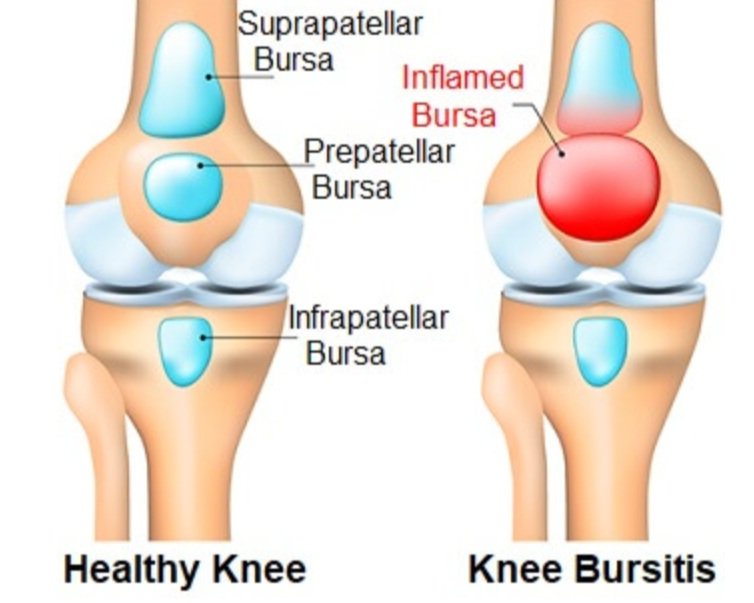Physical Therapy for Knee Bursitis
Knee bursitis involves inflammation of one or more bursae of the knee joint, causing pain, swelling, and limited mobility in the knee. Bursae are fluid-filled sacs that serve as cushions to reduce friction between bone and skin or bone and tendon. Knee bursitis can develop from a direct blow to the knee or from repetitive stress movements or pressure on the knee over time. Physical therapy for knee bursitis can help reduce pain, swelling, and stiffness in the knee and restore mobility in the knee through targeted therapeutic exercise and manual therapy.
Bursae of the Knee
The knee is the largest joint in the body and is built for weight-bearing, providing stability and mobility in the lower extremity. The knee joint is surrounded by eleven bursae, fluid-filled sacs that serve as cushions to reduce friction between bone and skin or bone and ligament or tendon.
The four major bursae of the knee include:
Suprapatellar bursa: this bursa is located between the femur and quadriceps, allowing free movement of the quadricep tendon over the femur and full bending and straightening of the knee.
Prepatellar bursa: this bursa is located at the top of the knee over the kneecap, allowing the kneecap to slide freely under the skin as the knee is bent and straightened.
Infrapatellar bursa: this bursa is located just below the kneecap under the large patellar tendon.
Anserine bursa: this bursa is located on the inside of the knee in the area where the hamstring muscle attaches to the lower leg.
What is Knee Bursitis?
Knee bursitis involves inflammation of one or more of the bursae of the knee joint, causing pain, swelling, and tenderness in the knee. Kneecap, or prepatellar, bursitis is the most common type of knee bursitis. Kneecap bursitis often develops in response to a direct blow to the knee or from repetitive stressful movements or pressure on the knee over an extended period of time. Knee bursitis is commonly seen in athletes, with up to 10% of runners developing knee bursitis at some point. While knee bursitis can develop rapidly after a traumatic blow to the knee, most cases of knee bursitis develop gradually over time due to chronic stress or pressure on the knee.
Causes of knee bursitis can include:
repetitive movement like running that stress the knee
prolonged kneeling such as when cleaning the floor, installing flooring, praying on your knees, or prolonged crawling (e.g. laying carpet)
a direct blow to the knee from a hit or from falling on the knee
following knee surgery or knee joint replacement
infection
autoimmune condition complications, e.g. osteoarthritis, gout, or rheumatoid arthritis
Symptoms of knee bursitis can include pain and tenderness over the location of the affected bursa, swelling at the knee, loss of knee mobility, and pain during activities that stress the bursa like kneeling, jumping, or running.
A direct blow to the knee can cause bleeding in the bursa sac because blood vessels in the tissues of the bursa become damaged or torn. On the skin, a bruise develops while internally the bursa swells up as the blood in the bursa causes an inflammatory reaction and the walls of the bursa thicken, becoming bursitis. With bursitis that develops over time, the repeated injury to the bursa through kneeling, running, or jumping irritates the bursa and causes it to thicken over time, causing bursitis.
Physical Therapy for Knee Bursitis
Physical therapy for knee bursitis can help reduce pain, swelling, and stiffness in the knee and restore mobility in the knee through targeted therapeutic exercise. Physical therapy for knee bursitis generally involves treatment for 2-8 weeks with swelling management, stretching, and strengthening exercise. During the first 24-48 hours of symptoms, apply light compression to the knee, rest the knee, and use ice to calm swelling. Once inflammation is reduced, the physical therapist implements a program of stretching and light strengthening to restore mobility in the knee and improve the strength of the knee and surrounding muscles to reduce stress on the knee joint.
Physical therapy treatment for knee bursitis can include:
Pain and swelling management by modifying aggravating activities and using ice, heat, and electrothermal modalities to control and reduce pain and swelling
Manual therapy hands-on soft tissue massage, passive stretching movements if tight leg muscles, and knee joint mobilizations to restore range of motion and flexibility in the knee
Therapeutic strengthening exercise to strengthen muscles of the knee and leg to support, stabilize, and decrease stresses placed on the bursae and tendons of the knee joint
Neuromuscular re-education and balance training to restore stability, retrain the lower extremity, improve balance, and improve movement techniques and mechanics when running, kneeling, jumping, and squatting to reduce stress on the knee, bursae, and tendons.
Agility training to enhance the speed and accuracy of leg and knee movements
Home exercise program
To prevent knee bursitis from developing, avoid kneeling for prolonged periods of time and use a knee pad or cushion when you have to kneel. Avoid hard hits to the knee and prolonged pressure to the front of the knee (take regular breaks if kneeling while working). Always warm up before an activity and gradually increase activity over time to allow your body to adjust safely. Increasing activity suddenly in duration and intensity can lead to injury. Follow a consistent leg and knee strengthening and flexibility program.
Knee bursitis can be extremely painful and limit your mobility and activities. Find relief today and regain strength with our physical therapists!


